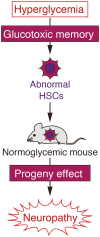Neuronal-Hematopoietic Cell Fusion in Diabetic Neuropathy
- PMID: 36976582
- PMCID: PMC10108719
- DOI: 10.1093/stcltm/szad015
Neuronal-Hematopoietic Cell Fusion in Diabetic Neuropathy
Abstract
Diabetic neuropathy is a major complication of diabetes mellitus that occurs during the early stages of the disease. Many pathogenic mechanisms are related and induced by hyperglycemia. However, even if these factors improve, diabetic neuropathy cannot go into remission and progresses slowly. Furthermore, diabetic neuropathy often progresses even with proper glycemic control. Recently, bone marrow-derived cells (BMDCs) were reported to be involved in the pathogenesis of diabetic neuropathy. BMDCs expressing proinsulin and TNFα migrate to the dorsal root ganglion and fuse with neurons, and this neuronal-hematopoietic cell fusion induces neuronal dysfunction and apoptosis. The CD106-positive lineage-sca1+c-kit+ (LSK) stem cell fraction in the bone marrow is strongly involved in cell fusion with neurons, leading to diabetic neuropathy. Surprisingly, when CD106-positive LSK stem cells obtained from diabetic mice were transplanted into nondiabetic mice, they fused with dorsal root ganglion neurons and induced neuropathy in non-hyperglycemic normal mice. The transplanted CD106-positive LSK fraction inherited the trait even after transplantation; this "progeny effect" may explain the irreversibility of diabetic neuropathy and is a significant finding for determining the target of radical treatments and provides new directions for developing therapeutic methods for diabetic neuropathy.
Keywords: Sca-1+c-Kit+Lin; bone marrow; diabetes; hematopoietic stem cell; neuropathy.
© The Author(s) 2023. Published by Oxford University Press.
Conflict of interest statement
The authors indicated no potential conflicts of interest.
Figures




References
Publication types
MeSH terms
LinkOut - more resources
Full Text Sources
Medical
Research Materials

